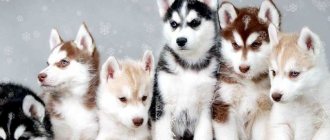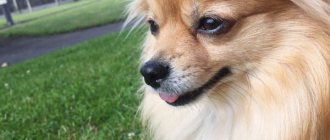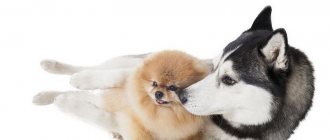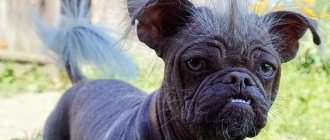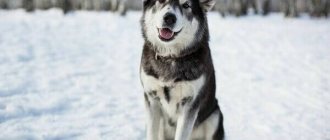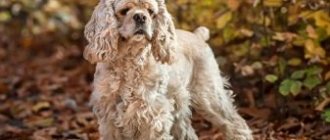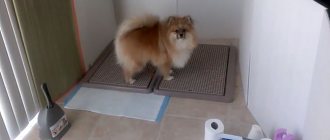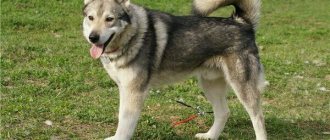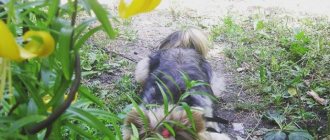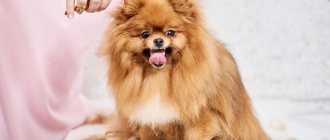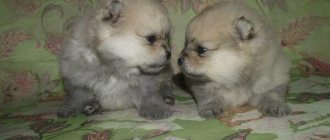| Origin: | USA |
| Usage: | companion dog |
| Color: | any (white, red, gray, brown, etc.) |
| Dimensions: | The weight of dogs of the first generation is 5-10 kg, of the second generation up to 7 kg. Height at the withers for the first generation is up to 40 cm, subsequent ones – 25-30 cm |
| Lifespan: | 13-15 years old |
In nature, hybrid animals are often found, that is, descendants of mixed pairs of different breeds and even species. In cynology, a person has learned to control the process of mixing breeds to obtain new qualities - these can be universal rescue dogs, guard dogs, and guide dogs. But some species are bred exclusively for decorative purposes - the so-called “designer breeds,” which include the Pomsky, a hybrid of the Pomeranian Spitz and the Siberian Husky. The breed has not yet been fully formed, is not recognized by the world canine community and does not have an official standard. This happens with many new breeds before they are recognized. Nevertheless, Pomskies exist and find new fans in many countries.
Pomsky - the loyalty of a husky and the playfulness of a spitz
Pomsky is the name of a crossbreed descended from two completely different breeds - the Pomeranian and the Siberian Husky. They first started talking about him at a veterinary forum, where they were interested in genetic diseases and the dog’s temperament. The online community user who opened the topic dreamed of having a four-legged friend from a dog shelter. Heated discussions and disputes began on social networks around the Pomsky, because the parent couple had significant differences in size.
Let's try to figure out how the breeders were able to develop such a variety?
Appearance
The dog, in one way or another, adopted dominant genes from each of the breeds: short stature from the Spitz, and cute erect ears from the Husky. The appearance of the muzzle can vary widely and take on a variety of shapes, the same applies to color, muscles, and all other parameters of appearance.
Unfortunately, it is impossible to give any accurate description and standard - hybrid breeds are unpredictable, and mass research and standardization have not been carried out. In general, the breed can be described as follows: a dog similar to a husky, small in size.
To read: Comparison of the two best fighting dogs, what is the difference between the Staffordshire Terrier (Amstaff) and the Pitbull?
The tail is slightly rounded, the paws are of medium length. The coat is very soft and has a dense undercoat - the dog will not freeze in winter. In 90% of cases you will see either beautiful blue eyes , or they will be of different colors (green-blue, yellow-green).
History of the origin of the crossbreed
The famous professional breeder, owner of a Siberian Husky nursery, Teresa Peterson, who lives in the American city of Burnsville, became seriously interested in the Pomsky. In 2013, puppies were born and officially registered. It is T. Peterson who is considered the ancestor.
Due to the different sizes, natural mating is almost impossible, so we had to resort to artificial insemination. A Siberian Husky dog acted as the mother to avoid pathological births.
Other breeders followed her example, thanks to whom, after a few years, there were already significantly more Pomskies.
Two clubs strictly control Pomsky breeding: RCA and ACHC (American Hybrid Dog Club). A list of breeders and their nurseries is published on their official websites. Other cynological organizations still do not recognize mestizos.
When purchasing a puppy, the new owner signs an agreement stating that upon reaching six months of age, the dog must be spayed or neutered. Veterinary confirmation of the operation will need to be sent to the club. Otherwise, you will have to answer to the law.
Without permitting documentation, it is prohibited to use Siberian Huskies and Pomeranians for crossing.
History of the breed
The Pomsky's homeland is the United States of America. The official appearance of this species dates back to 2013.
The breed is still very young. Despite this, she has already earned enormous popularity in her homeland. In 2022, UK dog handlers are already delighted with her.
Now Pomskies have spread throughout Europe and the former countries of the Soviet Union.
Photos of cute dogs with a “glossy” appearance filled the Internet even before the official introduction of a new type of mestizos.
The formation of a breed is a complex process. The thing is that a unified Pomsky standard has not yet been established.
In the future, the new type of mestizos is predicted to gain even greater fame and popularity. Today, associations of Pomsky lovers have been created in America and Canada.
But the breed has not yet received official recognition from international cynological federations.
Description and features
Crossing dogs has been resorted to more than once. Some use hybridization to obtain new workers, others try to improve the existing stock.
For what purpose were Pomskies bred? Probably just to get a positive companion. Dogs have a unique, inimitable character and attractive appearance. The pet will delight household members with its playful temperament, goodwill, and open communication.
From the Pomeranian he got a rich fur coat, a cheerful disposition, and a tireless desire to have fun, and from the Husky he got attractive eyes and incredible endurance. Both Pomsky breeds inherited only the best qualities. Some breeders generally claim that the hybrid is devoid of any disadvantages.
Pomsky is a dog with sociable character traits. She is loyal to her owners and tries to keep up with them. A hybrid of a Spitz and a Husky will be a faithful, affectionate, devoted pet.
A huge advantage of a crossbreed is its incredibly stable psyche. The dogs are well controlled, amenable to training, and quickly make contact with humans.
Due to the fact that Pomeranians and Siberian Huskies have many different colors, Pomskies can also be black and white, chocolate, copper, sable, fawn or white.
Dimensions and weight
The height of the Pomsky at the withers reaches a maximum of 40 cm, and the body weight of representatives of this breed depends on the generation of the litter and the weight of the parents.
So, dogs of the first generation weigh on average 4-12 kg, and of the second - from 4 to 10 kg.
Mixed breeds have pronounced sexual dimorphism - males are taller and heavier than females.
The approximate weight of an adult Pomsky can be determined by adding the weight of both parents and dividing the resulting figure in half..
Advantages and disadvantages
The main advantage, in addition to attractiveness, should be considered good health, as well as the absence of genetically determined diseases to which ancestors are susceptible. Proper care, maintenance, and feeding make it possible to encounter problems only in older individuals, and even then they are purely age-related.
Other advantages:
- Easily trainable;
- Devotees;
- Good-natured;
- They live a long time, about 14-15 years.
Minuses:
- Predisposition to the formation of tartar;
- Active physical activity is required;
- Tendency to howl;
- Lack of security qualities.
Despite the fact that crossbreeds were bred relatively recently, they have already managed to win thousands of human hearts.
Key points in training
It is necessary to raise the descendants of primitive Spitz dogs from the first day they appear in the house. Mixed breeds have a rather stubborn disposition, but in puppyhood they are quite easy to control. Training must be done with positive reinforcement, otherwise the Pomsky may completely refuse to follow commands.
Pomskys use their favorite toy or treat as motivation.
From the husky, the breed inherited a tendency to run away, therefore, unless you have achieved 100% obedience from your pet, it is not recommended to let it off the leash. Training should be short but daily. It is better to practice 1 command for 5 minutes, but 3 – 4 times a day. This way the puppy doesn’t get tired of the activities, and working with the owner becomes much more interesting.
Despite its miniature size and pretty face, the Pomsky is absolutely not suitable for a novice dog breeder. The breed requires persistent and systematic training. The trainer must be even more stubborn than the dog itself.
Read about how to properly train a dog in the article: “Training a puppy: effective methods from dog handlers, learning commands at home.”
Breed standard and varieties
There is no need to talk about a constant standard or description of a crossbreed. The appearance of each individual still depends on the play of genes. Remembering Mendel's genetic laws, we can confidently say that the first generation of hybrids (F1) receives an equal number of traits from their mother and father. Half of the litter turns out to be husky-like puppies, and the other half are spitz-like. Usually, a Spitz male and a Husky female are taken for crossing, because it will be more difficult for the Pomeranian to bear large fruits.
F1 dogs can mate with each other, but the results will not be as impressive. Each crossing of subsequent generations is reflected in the appearance not in the best way. Mestizos will be very different from their older brothers in appearance, and in the end these matings will lead to degeneration. This is probably why it is so rare to see advertisements for the sale of third generation puppies.
The average F1 hybrid is a dog weighing approximately 6-7 kg and 30-40 cm tall. The sexual dimorphism of the Pomsky is pronounced, manifested in the fact that females are smaller and lighter than males.
In order to at least somehow divide the crossbreeds according to external characteristics, breeders tried to describe the five main exterior types, which we will now talk about. Different lines indicate the interaction of genes and the predominance of one over the other.
Fox type Pomsky
The main characteristic of this type is its sharp muzzle, which looks like a fox. The color also fully embodies the name - red. The Pomsky inherited a long body from the Siberian Husky, and a light frame from the Spitz. There are protruding ears on the head.
Plush
The plush appearance is created by the short, padded coat. The dog's body is small in size, approximately like that of a Spitz, but the color comes from a husky. The muzzle is shortened. The thick tail is rounded into a tight ring.
Pomsky white
This type of hybrid is very rare. The dog's coat is short but thick, the undercoat is well developed. The color of the mestizo is like snow-white snow. The short muzzle has a medium-sized nose. The dog itself is quite large.
Brown Pomsky with blue eyes
Even for Siberian Huskies, the combination of brown color and blue eyes is considered rare, let alone hybrids. The pigmentation of the lips, nose, and eyes is brown. The undercoat is well developed.
Shorthaired Pomsky
Not the most popular variety of Pomsky. For some reason it is in the least demand among people. The weight of adult individuals varies from 5 to 13 kg, and height - 25-40 cm.
How to tell the difference when purchasing?
The great popularity of Pomskys among dog lovers and the high demand for this breed have led to the emergence of many scammers who pass off crosses of other breeds as Pomskys. The lack of a breed standard also complicates the purchase, as well as the fact that mainly first-generation puppies are popular.
What you should pay attention to before purchasing a puppy:
- Parents' pedigree. Puppies of the first appear only as a result of direct crossing of purebred Husky and Spitz.
- The puppy's health status. The puppy must have a proportional body, a soft, uniform coat without bald spots and clean, without excessive secretions of the mucous membranes of the nose and eyes.
- Behavior . The Pomsky should be playful, cheerful, sociable, without signs of aggression, and have a good appetite.
In addition, real Pomskies are expensive, the price depends both on the pedigree of the parents and on the color of the dog. If the puppy costs less than $1,500, it is most likely a second-generation hybrid or not a Pomsky at all, but a representative of a similar breed.
Despite all these signs, full confidence in the origin of the dog can only be obtained after a DNA analysis of the puppy.
Character and behavioral characteristics
Despite the popularity and prevalence of Pomskies, as far as character is concerned, they can be considered “dark horses”. They inherit behavior and temperament from the parent couple, but this does not prevent dogs from adding individual character traits to the “inheritance” of their ancestors, which makes them somewhat unpredictable.
In general, these are dogs with a playful, mischievous disposition, sociable temperament, and a penchant for adventure. Therefore, there are frequent cases of escapes while walking with the owner. Pomskies are happy to stumble upon an adventure or the next round of trouble.
In a family, dogs behave friendly, openly, they quickly become attached and make contact. But you shouldn’t expect equal love for all household members. A Pomsky will always have one favorite owner, whose opinion he will listen to a little more than the others. But again, universal worship, boundless devotion to man - this is not about them.
Does this breed get along with other pets?
Unfortunately, Pomskies and other animals don't always mix well. This breed has a high prey drive inherited from their Husky parent, meaning that small animals such as cats or guinea pigs may not feel safe around them.
When it comes to other dogs, if your Pomsky is properly socialized from the start, they can learn to get along.
Education and training
Socialization and education are important for any breed, and doubly so for a mixed breed, from whom you don’t know what to expect. By neglecting training, you risk getting a disobedient, wayward pet.
Like huskies, Pomskies are quite intelligent, but their sense of adventure outweighs them. Therefore, the owner will have to not only teach the animal commands and behavior patterns, but also learn to predict unwanted actions himself.
The Pomsky will test the owner's authority by occasionally trying to break the rules. Only a person with a strong character can gain leadership.
Any professional dog trainer will tell you that it is better to start obedience training at three months, i.e. from the moment the puppy appears in the house. Kids willingly explore the world around them at this age, are open to new knowledge and have not yet acquired bad habits.
A small puppy is not able to concentrate on a lesson for a long time, so the first training should be no more than 15 minutes.
From the first days of life in a new home, establish rules of behavior for your pet. All household members should adhere to the same training method, without succumbing to the puppy’s tricks. The dog should have separate places to rest and feed.
Unobtrusive training should begin with joint games. An overly strict and rude attitude during classes will lead to the opposite result: the animal will stop obeying at all, and possibly get out of control. Excessive affection is also not the most suitable option, so the owner will have to find that golden mean. A balance of negative and positive reinforcement will quickly lead to the desired results.
Tips for choosing
Choosing the right place to purchase a puppy will eliminate the possibility of buying a sick dog with pathologies. It is best to purchase a pet from nurseries after first getting to know the breeder and the puppy’s parents, as well as assessing the conditions in which the animals are kept.
Ungroomed, sick dogs kept in dirty enclosures and the breeder’s avoidance of answering questions and refusal to present the pedigree and medical records of the parents are reasons to be wary.
When choosing a puppy, you need to pay attention not only to its appearance, but also to its activity, as well as to:
- Cleanliness, uniformity, thickness of the coat.
- No discharge from the eyes.
- Proportionality of the abdomen.
- Ear placement - they should look up.
- No skin inflammation.
- Cleanliness of the ears.
Also, you should not buy a puppy before it is 2-3 months old. It is at this age that breed traits begin to appear and it is easier to judge what kind of adult dog will be.
Health
Pomskies, despite their artificial breeding, have a good immune system, thanks to which they practically do not suffer from viral diseases. It would seem that they should inherit the diseases that affect the Siberian Husky and Pomeranian Spitz. But this is far from true.
The flaws still exist. For example, a Pomsky's weak point is its teeth. Very often, tartar forms, the appearance of which can be prevented by timely laser cleaning. These procedures are carried out in veterinary clinics. It is not difficult to detect the symptoms of tartar: the color of the tooth near the gum becomes yellowish. At this stage, you can easily remove it yourself with a brush. Then a process of mineralization will follow, the consequences of which the owner will no longer be able to cope with on his own. If left untreated, the stone will change color to dark brown and become much larger.
And most importantly, we must not forget about preventive dewormings and vaccinations on schedule. Vaccinations are required for all dogs. This saves not only the life of the pet, but also the health of other family members. In addition, in the absence of vaccinations and appropriate marks in the veterinary passport, the dog cannot be transported across the border.
Many health problems can be prevented in time by regularly visiting a veterinarian.
Nutrition
The Pomsky's diet should be balanced, with sufficient energy value, containing essential vitamins, microelements, and amino acids. Dry food of the holistic, super premium and premium classes can provide the correct diet. Feeding ready-made food allows you not to worry about vitamin supplements, food freshness, overeating or undereating your pet. The dry diet can be varied with wet canned food, while giving preference to food from one manufacturer and one brand. We have already written about how to choose dog food and how to feed your dog dry food.
Adherents of natural nutrition should know that dogs should absolutely not be given:
- fatty foods;
- smoked and pickled foods;
- baked goods and sweets, chocolate;
- raw meat and fish;
- bones.
A natural diet should also be balanced in nutritional value and content of nutrients:
- 50-60% of the daily portion of food should be meat (veal, lamb, poultry, rabbit);
- 20-25% vegetables and fruits;
- 25-30% cereals;
- 5% fermented milk products.
A natural diet should include eggs (chicken, quail), offal (liver, tongue, tripe, heart, lungs), and low-fat fish. It is advisable to consult with the breeder or veterinarian regarding the introduction of vitamin and mineral supplements.
Maintenance and care
The average Pomsky is still a good-natured person. He rarely starts fights; most likely, he is the first to become a victim among his relatives. Therefore, it is best to keep a dog in apartment conditions.
A chain or a booth in the yard is not at all suitable for these mestizos. This doesn't make any sense, because... They do not possess protective qualities, and without communication, constant contact with humans, dogs will become uncontrollable.
The Pomsky is an animal with a big heart. These dogs are incredibly loving and sociable, so living in isolation from humans is not the best option for them.
Keeping a pet doesn't have to be difficult. The coat does not mat, so regular brushing will be sufficient (once every couple of weeks). During the period of active shedding, brushing should be done daily.
It is recommended to bathe your pet no more than once every six months. In this case, special cosmetics for dogs should be used. After bathing, it is recommended to thoroughly dry the animal with a hairdryer.
Walk
Pomskies must be walked under the supervision of their owner. In crowded places, you should not let your dog off the leash, even if it has completed a full training course. To give your animal plenty of time to run around, go for a walk in a forest or field where there are no people, cars or other animals. Walking should last at least an hour so that the dog uses up its accumulated energy.
Feeding
The owner of a Pomsky can keep it on a natural or prepared diet. Among dry food, it is better to choose premium or super-premium brands. All cheap food is made from plant products with the addition of a bunch of flavorings, chemicals and dyes. And this does not have the best effect on the functioning of the digestive system and the health of the dog in general.
A natural diet should consist of 70% lean meat. Among cereals, you should give preference to rice, buckwheat or oatmeal. You need to add seasonal vegetables and heat-treated fruits to your food. To replenish omega-3 fatty acids, the menu should contain sea fish. Don't forget to add low-fat fermented milk products several times a week.
The following should be completely excluded from the diet:
- Fat;
- Smoked;
- Spicy;
- Sweet, salty;
- I'll bake it.
Remember, when choosing a natural menu, you must use vitamin and mineral supplements for your four-legged friend. It is very difficult to properly balance feeding.
